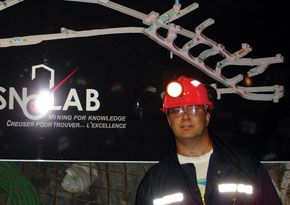 DANIEL BUENOIn 2008, at age 41, Eduardo do Couto e Silva was deputy coordinator of a 38-member team at the SLAC National Accelerator Laboratory of the Department of Energy, administered by Stanford University, and had been instrumental in building the Fermi Space Telescope, which involved the research centers of five countries (United States, Japan, Sweden, Italy and France). “I learned that in order to work on visionary projects, you have to be willing to take chances and believe that something good will always come out in the end,” he says. When the telescope settled down in space, Couto e Silva went to the laboratory’s director and told her he needed a bigger challenge. “She and the other directors believed in my potential and supported me. Again I chose the hardest job, building a sophisticated instrument to operate in an underground laboratory to detect the presence of dark matter, for which we still had no financing.
DANIEL BUENOIn 2008, at age 41, Eduardo do Couto e Silva was deputy coordinator of a 38-member team at the SLAC National Accelerator Laboratory of the Department of Energy, administered by Stanford University, and had been instrumental in building the Fermi Space Telescope, which involved the research centers of five countries (United States, Japan, Sweden, Italy and France). “I learned that in order to work on visionary projects, you have to be willing to take chances and believe that something good will always come out in the end,” he says. When the telescope settled down in space, Couto e Silva went to the laboratory’s director and told her he needed a bigger challenge. “She and the other directors believed in my potential and supported me. Again I chose the hardest job, building a sophisticated instrument to operate in an underground laboratory to detect the presence of dark matter, for which we still had no financing.
Couto e Silva had already chosen the most difficult path upon arriving in the United States in 1989 to attend graduate school after having studied physics at the University of Brasilia (UnB). His plan was to study condensed matter at Indiana University, but a lecture on particle physics, a field that was entirely new to him, attracted him so much that he enrolled in a doctoral program on particle accelerators at the European Organization for Nuclear Research (CERN) in Switzerland. “At CERN, in addition to being a researcher, I worked as a volunteer at the museum, primarily with children, and was invited to participate in meetings with US officials to certify that this research work at CERN was working.”

PERSONAL COLLECTIONCouto e Silva in an underground laboratory in 2009PERSONAL COLLECTION
He stayed there until 1999 and then returned to the United States to work in high energy astrophysics. In 2012, to the astonishment of his Stanford colleagues, Couto e Silva decided to return to Brazil. “I saw an institutionalization emerging in Brazil in the area of science and technology and thought I could help a lot with the experience I’d gained abroad,” he said.
He resigned even though he had no job offers, but soon found work as a visiting researcher at the Center for Management and Strategic Studies (CGEE) in Brasilia, and joined UnB as a visiting professor. In reflecting on the state of Brazilian scientists abroad, he and sociologist Elizabeth Balbachevsky of the University of São Paulo (USP), wrote the article “The Brazilian scientific diaspora: outlook for their contributions to Brazilian science,” published in 2011 in Strategic Partnerships. “We need to bring in more Brazilians who work in other countries and also help those who are abroad to see how they can work with Brazil.”
After working on a project at the request of the Brazilian Physics Society (SBF) to promote dialogue between entrepreneurs and physicists, for purposes of developing joint projects and providing jobs for physicists (see Pesquisa FAPESP No. 193, March 2012), he is now part of the group that supports the strategic expansion of the Technological Institute of Aeronautics (ITA). The prospect of an agreement between the Massachusetts Institute of Technology (MIT) and ITA has made him return frequently to the United States. Now, he says, “knowing how they think, but positioning myself as a Brazilian, is very rewarding for me.”
Republish